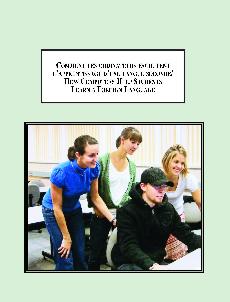Comment Les Ordinateurs Facilitent L’apprentissage D’une Langue Seconde / How Computers Help Students Learn a Foreign Language: Recherche Experimentale Sur La Collaboration En Ligne
We are currently unable to ship to the EU countries at this time. We apologize for this inconvenience.

| Author: | Ragoonaden, Karen | |
| Year: | 2010 | |
| Pages: | 300 | |
| ISBN: | 0-7734-3773-9 978-0-7734-3773-8 | |
| Price: | $199.95 + shipping | |
| (Click the PayPal button to buy) | ||
Studies the benefits and the disadvantages of on-line collaborative learning in Distance Education courses. In order to verify how interaction and collaboration work between students in distance education courses, the author makes the distinction between collaboration and cooperation and discusses how interactions between learners occur in a virtual environment.
Reviews
“Does the establishment of social relationships online bring with it the need to also establish mutual helping relationships, or learning collaboration networks? What is the quality level of those relationships, how are they produced, what is their working language? The answer to these questions and to many others, particularly those related to evaluation methods raised by the author of this work, and which must also distance themselves from traditional modes, will allow us to outline the foundation of a new language, that of Internet learning.”
– Prof. Pierre Bordeleau, Université de Montréal
“ The results of this research are very important as they allow one to offer guidelines to undergraduate university Web-based course designers. Whether it is a question of revisiting the collaborative activities within the context of a constructivist approach, the nature of the evaluations or the manner in which the learners were grouped into teams, Dr. Ragoonaden’s book is rich in suggestions aiming to maximize the Internet’s potential, in order to ensure the delivery of high-quality teaching to the ever-growing clientele of online university training.” – Prof. André Samson, College universitaire de Saint-Boniface
“This study is important because it does subject the pedagogical use of the Internet to scrutiny in an empirical inquiry. Increasing use of Internet attributes may make learning via the Internet a more effective and more popular. There is the possibility, too, that more effective collaboration between online users may occur with more reliable technological facilities, and more specially focused on-line software. There is still, though, the need to undertake more research assessing the effectiveness and evaluating the impact on student learning online in an Internet-based environment.” – Dr. Robert Campell, University of British Columbia Okanagan
“ The results of this research are very important as they allow one to offer guidelines to undergraduate university Web-based course designers. Whether it is a question of revisiting the collaborative activities within the context of a constructivist approach, the nature of the evaluations or the manner in which the learners were grouped into teams, Dr. Ragoonaden’s book is rich in suggestions aiming to maximize the Internet’s potential, in order to ensure the delivery of high-quality teaching to the ever-growing clientele of online university training.” – Prof. André Samson, College universitaire de Saint-Boniface
“This study is important because it does subject the pedagogical use of the Internet to scrutiny in an empirical inquiry. Increasing use of Internet attributes may make learning via the Internet a more effective and more popular. There is the possibility, too, that more effective collaboration between online users may occur with more reliable technological facilities, and more specially focused on-line software. There is still, though, the need to undertake more research assessing the effectiveness and evaluating the impact on student learning online in an Internet-based environment.” – Dr. Robert Campell, University of British Columbia Okanagan
Table of Contents
Liste des tableaux
Préface by Pierre Bordeleau, professeur honoraire
Remerciements
Introduction
Chapitre:
1 L’apprentissage en ligne
2 L’apprentissage collaboratif
3 Les cours offerts à distance en ligne
4 Les défis posés par un apprentissage virtuel
5 Conclusion
Liste Des Annexes:
Annexe 1A - Apprentissage collaboratif et Internet
Annexe 2A -L’interview formelle
Annexe 3A - L'interview ouverte standardisée
Annexe 4A - Les mécanismes de collaboration
Annexe 5A - L’interactivité des médias
Annexe 6A - Les réponses complètes au questionnaire 3A
Annexe 7A - Activité collaborative no 1
Annexe 8A - Activité collaborative no 2
Annexe 9A - Activité collaborative no 2
Annexe 10A - Activité collaborative no 3
Annexe 11A - Activité collaborative no 3
Annexe 12A - Évaluation des cours du professeur
Références
Préface by Pierre Bordeleau, professeur honoraire
Remerciements
Introduction
Chapitre:
1 L’apprentissage en ligne
2 L’apprentissage collaboratif
3 Les cours offerts à distance en ligne
4 Les défis posés par un apprentissage virtuel
5 Conclusion
Liste Des Annexes:
Annexe 1A - Apprentissage collaboratif et Internet
Annexe 2A -L’interview formelle
Annexe 3A - L'interview ouverte standardisée
Annexe 4A - Les mécanismes de collaboration
Annexe 5A - L’interactivité des médias
Annexe 6A - Les réponses complètes au questionnaire 3A
Annexe 7A - Activité collaborative no 1
Annexe 8A - Activité collaborative no 2
Annexe 9A - Activité collaborative no 2
Annexe 10A - Activité collaborative no 3
Annexe 11A - Activité collaborative no 3
Annexe 12A - Évaluation des cours du professeur
Références
Other Education & Educational Teaching Methods Books
2009 - Sociological Study of Women’s Educational Networks in India: Changing Lives From the Ground Up
>> See all our Education & Educational Teaching Methods books